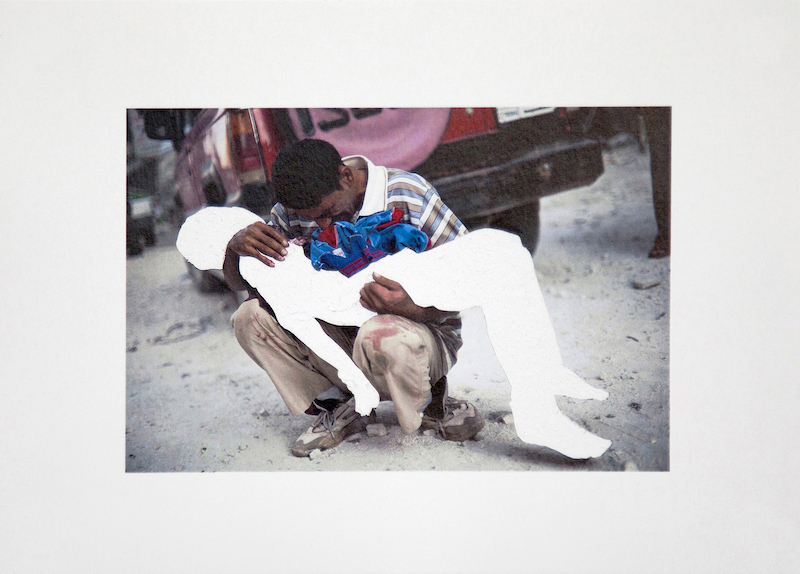Sorrow takes hold of John Quin in a pathos-laden group exhibition
While two museum guides are pointing me towards the café, a woman’s singing, hymnlike, suddenly soars from somewhere behind them. I quip, “Gott kommt!” – God is coming – and they don’t laugh, knowing what I’m in for: an emotional wringing through Mourning’s mangle of death. The vocalising constitutes the first work in the show, a sound installation called Four Part Harmony (2020) by Susan Philipsz. Based on an old Irish folksong, it refers to the Celtic tradition of keening – ritualised singing for the deceased. The atrium fills with the artist’s haunting voice, the composition arranged in ascending and descending scales.
The key work in this show, which brings together some 30 artists from 15 countries, comes next: Andy Warhol’s Jackie (1964). The small silvery silkscreen has JFK’s widow sunk deep in her new world of emptiness and pain, and sets the tone for the show: it’s another descent, a soul plunge like a prolonged sigh. Bereavement can be disturbingly upsetting, as with Adrian Paci’s Interregnum (2017), with its edited video footage of mass mourning following the deaths of Stalin, Mao and other dictators. How frightening to witness the ease of manipulated hysteria. Some seem genuinely upset; not a few, you suspect, are faking it. What disturbs is that you are never sure which.
Bas Jan Ader’s I’m too sad to tell you (1970–71) is still too sad to look at for long, even if you don’t know his fate. Unfortunately Ragnar Kjartansson’s God (2007), installed in the next room, comes across as slight alongside such heavyweight pathos. The Icelandic artist croons, in the louche manner of a 1950s torch singer, that “sorrow conquers happiness”. (Cheers for that.) A moment of tragicomic respite arrives via two Ghanaian artists who design coffins. Ataa Oko’s 80 Zeichnungen (2004–07) is a grid of drawings picturing speculative coffins – shaped like ducks, cars, crabs – while Kudjoe Affutu’s celebratory orange-and-black-striped wooden minicoffin, Tiger (2006), might look good on (what was once) your mantelpiece.
More acute sadness arrives with photojournalist Paul Fusco’s famous RFK Funeral Train (1968/2019). Mourners stand mute alongside the tracks as the body of the assassinated senator is transported to Washington, DC. We see black and white, young and old, united as if in Martin Luther King, Jr’s dream but in reality together only in tragedy. The death of hope is right here. Philippe Parreno’s short video reenactment, June 8, 1968 (2009), if anything reintensifies the grief: on watching, all shifts dreamily – to paraphrase Seamus Heaney’s poem ‘A Northern Hoard’ (1972) – while, in the distance, Philipsz keens.
Philipsz has two more works here. One, Returning (2004), is a film loop of people visiting the Karl Liebknecht memorial in Berlin’s Tiergarten; another political hero assassinated, another utopian vision crushed. Things get even sadder with Aslan Ġoisum’s video People of No Consequence (2016), where a hall in Grozny slowly fills with shuffling elderly people, the last 119 survivors of Stalin’s forced deportations from Chechnya. The worst is saved for last: the violent death of a child. How to show what should never be seen? Khaled Barakeh’s series The Untitled Images (2014), altered photographs from the war in Syria, aim straight for the gut. He uses a scalpel to excise the victims from the picture. But the adults remain intact holding the child-shape, a white void; the slumped, defeated postures of the living horrify. With wilful political ignorance of humanitarian truths all around, and scientific concerns about the death of the planet, a show majoring on grief that accentuates the personal and communitarian implications of mourning seems entirely appropriate to the moment.
Mourning: On Loss and Change, Hamburger Kunsthalle, 7 February – 14 June 2020
From the April 2020 issue of ArtReview
